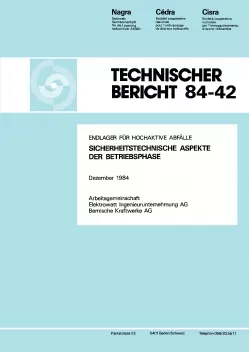
Technischer Bericht NTB 84-42
Endlager für hochaktive AbfälleSicherheitstechnische Aspekte der Betriebsphase
Compliance with applicable regulations and rules cannot completely prevent the occurence of incidents during the operational phase of a nuclear waste repository. Incidents, breakdown of different equipment etc. could be caused despite such preventive measures by natural phenomena, by wear and tear of components or by human error.
This report addresses mainly the question, whether any unacceptable radiological release would occur from a disposal facility for high level waste during its operational phase, either from routine operation or in the wake of operational incidents.
The corresponding safety assessment is based on the conceptual type-C repository that was developed by Nagra and its contractors in the framework of Projekt Gewähr 1985 and which is described in detail in Nagra report NGB 85-03. Three different kinds of waste are to be disposed of in this mine-type repository. They originate from reprocessing plants in which the spent fuel elements of nuclear reactors are treated.
The present report suggests numerous accident scenarios which are initiated by both repository internal and external causes. These scenarios are representative for waste disposal facilities and they envelop all credible incident situations in such plants.
Amongst the discussed scenarios an in depth analysis is performed only for those, for which worst accident consequences can be expected. In the detail calculations the assumptions used are always conservative and yield therefore pessimistic results. This practice is standard for safety analyses in the nuclear field.
The investigations described briefly in this report have led to the following conclusions:
The barriers created around the waste material are very efficient and prevent radioactive releases during operations in the waste repository. This is mainly achieved by fixing the radioactive nuclides within a matrix material, e.i. glass, bitumen or cement. Additionally, several other barriers are completely enclosing the waste material whenever it is transported, handled or stored. The backfill material, which is put in place shortly after the deposition of waste packages, is also minimizing potential accident consequences.
During normal, undisturbed repository operation no radioactivity is released from the repository to the environment.
Even severe hypothetical incidents will only lead to minor radioactive discharges into the environment. The consequences of such releases will hence remain well within acceptable limits.
In summary, with respect to radioactive exposures, it can be stated that no danger arises from the operation of the proposed type-C waste repository for the population and the environment.
